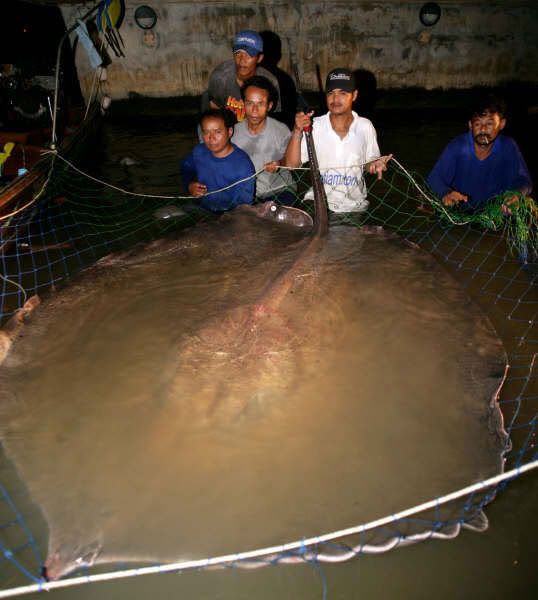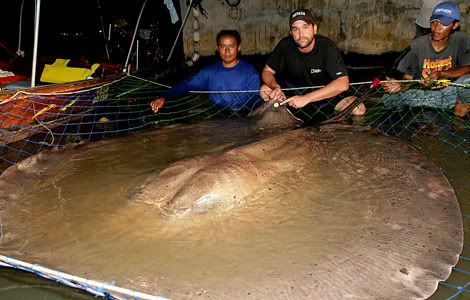Gone fishing...
I knew the Mekong Catfish was one big mofo (and in fact holds the record for biggest freshwater fish ever caught at 646 pounds, but till the other night, I did not realise that Thailand had an even bigger creature lurking below the rivers...
When anglers called that March afternoon to say they had caught a giant freshwater stingray near this bustling Thai city (Chachoengsao), biologist Zeb Hogan couldn't believe it.
He had just spent a week in the remote Mekong River in northern Cambodia, searching for the ray—which might be the world's largest freshwater fish species—to no avail.
Hogan, of the University of Nevada in Reno, is documenting the rays as part of the Megafishes Project, an effort to document Earth's 20 or so freshwater giants.
Hogan is also a National Geographic Society Emerging Explorer. (National Geographic News is part of the National Geographic Society.)
Many of these behemoths, including the giant stingray, have declined in recent years. The ray, listed as "vulnerable" on the 2007 World Conservation Union Red List of species, has been overfished in its Mekong River habitat, Hogan said.
But when Hogan arrived at the river that afternoon, he found that not only had the anglers reeled in a 14-foot-long (4.3-meter-long) ray, but that the creature had also just given birth to a dinner plate-size baby.
The newborn clung to the rough skin on the back of its mother, which was being held at the riverbank by nine handlers.
"Amazing," Hogan said. "A stingray this size giving birth before our eyes.
Megafish Title
The giant freshwater stingray, also known as the freshwater whip ray, is found in several rivers in Southeast Asia and northern Australia.
There are unverified accounts of individuals growing well over 1,000 pounds (450 kilograms) in weight and more than 20 feet (6 meters) in length—among the largest of the approximately 200 species of rays.
To qualify as a "megafish," a species must grow to at least 6.5 feet (2 meters) in length or 220 pounds (100 kilograms) in weight.
"It's been a goal of mine for a long time to see if these stories of huge stingrays are really true," Hogan said.
Until now the Mekong giant catfish holds the official record as the largest freshwater fish ever caught, with a 2005 catch in Thailand tipping the scales at 646 pounds (293 kilograms).
Unknowns
Much is still unknown about the mammoth ray, which was only described scientifically in 1989.
"We know almost nothing about its abundance and habitat needs, which makes it extremely difficult to manage the species," Hogan said.
No one knows whether the species is truly a freshwater fish or if it can also move into the ocean.
But the behavior of the ray can be gleaned just from the way it looks, he pointed out.
"It has eyes on top, and the spiracles [breathing holes] are modified gill slits that allow the ray to breathe as it's buried in mud."
The ray feeds on clams and crabs using jelly-filled pores that are able to detect electrical pulses from its prey, he said.
Its barb, or stinger, located at the base of its whiplike tail, can grow 15 inches (37.5 centimeters) long and is the largest of any stingray's.
"The tip is sharp like an arrowhead, passes through skin easily, and can even go through bone," Hogan said as he held the tail of the mother ray, his face just inches from its 9-inch (22-centimeter) barb.
The barb is covered with a sheath of toxin that is injected into a wound. In 2006 Steve Irwin, the "Crocodile Hunter," died after his heart was fatally pierced by a barb.
In March a woman died boating in Florida after a spotted eagle ray jumped out of the water and hit her in the head.
Hogan said those incidents were freak occurrences, and that stingrays never purposefully attack people.
"We need to absolutely rid our minds of stingrays as dangerous creatures and become more curious about them and protect them," he said.
"They're incredible animals," Hogan said as he watched the giant mother ray swim back into the river, the baby clinging to its back.
"Hooking Into a Submarine"
Despite fishing pressures in Cambodia, in the Bang Pakong River in eastern Thailand, stingray populations appear to be healthy.
It may seem surprising that the giant creatures could thrive in an area densely populated by people, Hogan said.
"You wouldn't expect to find tigers or wild elephants or any other large, wild creatures in an urban environment like this," he said.
"But it's quite possible that the reason healthy populations of giant freshwater stingray still occur is because they're so difficult to catch."
To snag a giant ray, fishers must use live bait as big as 2.2 pounds (1 kilogram).
When caught, a 200-pound (91-kilograms) stingray may bury itself under 200 pounds (91 kilograms) of mud, making it almost impossible for people to lift it out of the water.
Wuttichai "Boy" Khuensuwan, co-owner of the fishing outfitter Fishsiam, said it's like "hooking into a submarine."
There are stories of hooked stingrays dragging boats for miles up and down the river, and even pulling boats underwater.
Earlier this spring Fishsiam anglers spent six hours—with 15 people taking turns at one rod—to bring in a stingray in the Bang Pakong River.
In comparison, it took fisher Niyom "Q" Phuttharaksa only about an hour and a half to bring in the pregnant mother that Hogan examined.
Once the fish is brought to the riverbank, it is secured with a rope or tube through its nasal cavity. The barb is immediately wrapped with a cloth to prevent injuries.
Rick Humphreys, co-owner of Fishsiam, said he has developed a fascination with the stingray.
"The fact that these fish are highly elusive, highly nomadic, totally understudied, and very rarely caught just helps fuel our obsession ... to actually see if this is the largest freshwater fish on the planet," he said.
On the Hunt
The day after the ray's birth, Hogan received a call from Cambodia: A fisher named Sok Long had caught a ray in the Mekong River, purported to be as big as the Thai 14-footer.
The biologist quickly got on a plane headed to Phnom Penh, the Cambodian capital.
"These catches are so rare, I don't want to miss out on any of them," he said. "We keep getting closer to these accounts I've heard of these unbelievably big fish.
"The more I learn about the giant freshwater stingray, the more I believe these unbelievable stories."
(story from national geographic)
Since that story, the record for the catfish has been broken; a British angler caught a 772 lb ray!!
http://www.guardian.co.uk/world/2009/feb/24/stingray-catch-thailand-fishing


![]()



0 Comments
Recommended Comments
Please sign in to comment
You will be able to leave a comment after signing in
Sign In Now